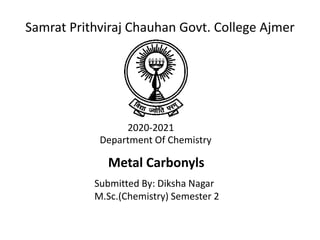
Metal Carbonyls
- 1. Samrat Prithviraj Chauhan Govt. College Ajmer 2020-2021 Department Of Chemistry Metal Carbonyls Submitted By: Diksha Nagar M.Sc.(Chemistry) Semester 2
- 2. Introduction Why study metal carbonyl? Molecular Orbital diagram of CO Infrared Spectroscopy- Spectra of Metal Carbonyls Reference CONTENT
- 3. Introduction Ludwig Mond 1839-1909 Father of Metal Carbonyl Chemistry Founder of Imperial Chemical Industry, England Metal carbonyls are organometallic compound formed by the combination of CO molecules with transition metal atoms in low oxidation state 1890-1930 textbooks Ni(CO)4 Fe(CO)5 Ni(CO)4, Fe(CO)5, Co2(CO)8, Mo(CO)6 1890 1891 1910
- 4. Examples Coordination number around the metal normally remains six or lesser. 17 electron species such as Mn(CO)5, Co(CO)4 dimerize to gain 18 electrons.V(CO)6 does not dimerize.
- 5. Why study metal carbonyls? Carbon monoxide is not ordinarily considered a very strong Lewis base and yet it forms strong bonds to the metals in these complexes. The metals are usually in the zero oxidation state and sometimes in negative oxidation state. Their complexes were distinctly different from the Werner complexes of NH3 and H2O ligands. They are always 18 electron complexes. Simplest of organometallic compounds where M-C bonding is well understood. CO is one of the strongest acceptor ligands. Back bonding ( bonding) and variation in electronic properties of CO can be monitored very efficiently by Infrared spectroscopy A range of metal carbonyls are used as catalysts in Chemical Industry. C CH2 R H CO, H2 CH CH2 HC R O H HCo(CO)4 Hydroformylation Alkene to Aldehyde
- 6. Molecular Orbital diagram of CO The highest occupied molecular orbital (HOMO) of CO is weakly antibonding molecular orbital and is MO which is carbon based. Secondly, the * antibonding orbital which is the lowest unoccupied molecular orbital (LUMO) is also of comparatively lower energy which makes it possible to interact with metal t2g orbitals for bonding. There exists a strong back bonding of metal electrons to the * antibonding orbitals of CO Why does CO bind a metal through its less electronegative carbon atom than its more electronegative oxygen ? What makes it a good acceptor ? AO of C atom AO of O atom MO of CO
- 8. Infrared Spectroscopy: Spectra of Metal Carbonyl Counting the electron helps to predict stability of metal carbonyls. But it will not tell you whether a CO is bridging or terminal. For this IR spectroscopy is very useful. Infrared spectroscopy is a particularly informative technique for characterizing carbonyl complexes. It is very useful in identifying the structures suggests the C-O bond order in M-CO complexes are lesser than in free. The CO bond vibrates around 2143cm-1 in the gaseous state. Fe OC OC OC Fe O C CO CO CO C O O C terminal bridging The range in which the band appears decides bridging or terminal
- 9. Terminal versus bridging carbonyls M C O M M C O terminal bridging 2 M M M C O bridging 3 2120-1850 cm-1 CO 1850-1700 cm-1 1730-1620 cm-1 Cr OC OC CO CO CO CO Fe Fe Fe OC Fe OC CO CO Cp Cp Cp Cp 2000 cm-1 1826 cm-1 1620 cm-1
- 10. Factors which affect CO stretching frequencies M C O M C O CO Higher CO Lower 1. Charge on the metal As the electron density on a metal centre increases, more backbonding to the CO ligand(s) takes place. This weakens the C–O bond further as more electron density is pumped into the empty * anti-bonding carbonyl orbital. This increases the M–C bond order and reduces the C-O bond order. That is, the resonance structure M=C=O becomes more dominant.
- 11. 2. Effect of ligands • With each negative charge added to the metal centre, the CO stretching frequency decreases by approximately 100 cm–1. • The better the donating capability of the other ligands on the metal, more electron density given to the metal, more back bonding (electrons in the antibonding orbital of CO) and lower the CO stretching frequency. Mo L L CO CO CO L More back bonding = More lowering of the C=O bond order = More lower CO stretching frequency
- 12. Uses of Infra-red(IR) Absorption Spectra of Metallic Carbonyls To determine the geometry of metallic carbonyls. To determine the bond order of ligated CO. To differentiate between terminal and bridging carbonyl groups. To study reaction rates.
- 13. Reference SHRIVER & ATKINS Inorganic Chemistry Inorganic Chemistry Principles of Structure and Reactivity By James E. Huheey, Ellen A. Keiter, Richard L. Keiter, Okhil K. Medhi Basic Organometallic Chemistry By B D Gupta, A J Elias
- 14. Thankyou